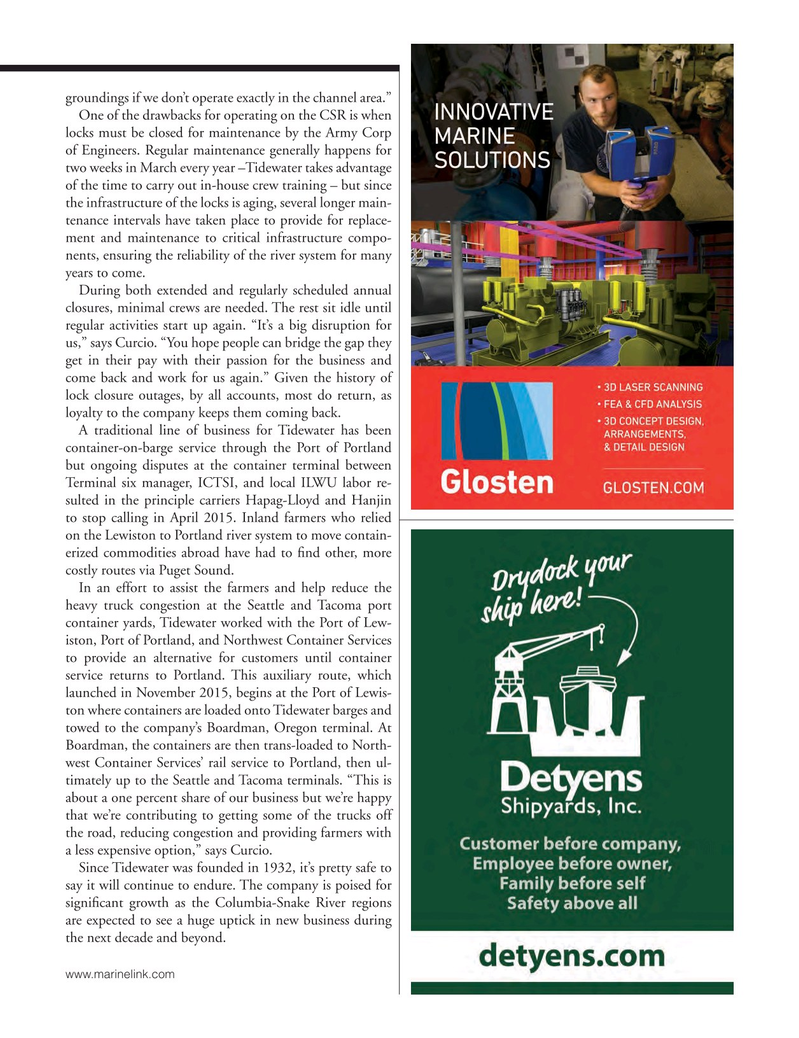
Page 43: of Marine News Magazine (March 2016)
Push boats, Tugs & Assist Vessels
Read this page in Pdf, Flash or Html5 edition of March 2016 Marine News Magazine
groundings if we don’t operate exactly in the channel area.”
One of the drawbacks for operating on the CSR is when locks must be closed for maintenance by the Army Corp of Engineers. Regular maintenance generally happens for two weeks in March every year –Tidewater takes advantage of the time to carry out in-house crew training – but since the infrastructure of the locks is aging, several longer main- tenance intervals have taken place to provide for replace- ment and maintenance to critical infrastructure compo- nents, ensuring the reliability of the river system for many years to come.
During both extended and regularly scheduled annual closures, minimal crews are needed. The rest sit idle until regular activities start up again. “It’s a big disruption for us,” says Curcio. “You hope people can bridge the gap they get in their pay with their passion for the business and come back and work for us again.” Given the history of lock closure outages, by all accounts, most do return, as loyalty to the company keeps them coming back.
A traditional line of business for Tidewater has been container-on-barge service through the Port of Portland but ongoing disputes at the container terminal between
Terminal six manager, ICTSI, and local ILWU labor re- sulted in the principle carriers Hapag-Lloyd and Hanjin to stop calling in April 2015. Inland farmers who relied on the Lewiston to Portland river system to move contain- erized commodities abroad have had to ? nd other, more costly routes via Puget Sound.
In an effort to assist the farmers and help reduce the heavy truck congestion at the Seattle and Tacoma port container yards, Tidewater worked with the Port of Lew- iston, Port of Portland, and Northwest Container Services to provide an alternative for customers until container service returns to Portland. This auxiliary route, which launched in November 2015, begins at the Port of Lewis- ton where containers are loaded onto Tidewater barges and towed to the company’s Boardman, Oregon terminal. At
Boardman, the containers are then trans-loaded to North- west Container Services’ rail service to Portland, then ul- timately up to the Seattle and Tacoma terminals. “This is about a one percent share of our business but we’re happy that we’re contributing to getting some of the trucks off the road, reducing congestion and providing farmers with a less expensive option,” says Curcio.
Since Tidewater was founded in 1932, it’s pretty safe to say it will continue to endure. The company is poised for signi? cant growth as the Columbia-Snake River regions are expected to see a huge uptick in new business during the next decade and beyond.
www.marinelink.com
MN Mar16 Layout 32-49.indd 43 2/19/2016 11:01:26 AM

 42
42

 44
44
